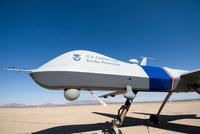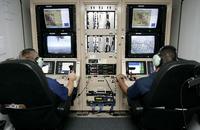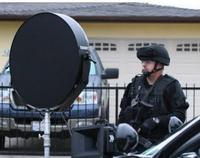-
Senate immigration bill could yield billions in federal contracts
The Senate immigration bill will see billions of dollars go to defense and technology companies as a result of billions of dollars in new and expanded federal contracts aiming to bolster border security.
-
-
Our farblondzhet senators

The Senate immigration reform bill has been presented as an effort to resolve the many complex problems resulting from the Immigration and Reform Act (IRCA) of 1986. Whether the bill passed by the Senate yesterday will succeed remains to be seen, but what is not in doubt is the fact that the border security provisions in the bill, in the words of Sen. Patrick Leahy (D-Vermont), read “like a Christmas wish list for Halliburton” and other big defense contractors. This is unfortunate, because the U.S.-Mexico border has become a graveyard for a long list of ambitious, technology-heavy – but ultimately ineffective and exceedingly wasteful – programs.
-
-
Texas sees rise in number of border crossers dying in the summer heat
During the hot summer months, dozens of migrants die trying to cross the southern border in Arizona and California. Now, Texas is seeing an increase in the number of immigrant dying as they cross the U.S.-Mexico border and lose their way in the desert.
-
-
Immigration bill gains more support
The immigration reform effort has been gaining support from Republican Senators — and from a couple of wavering Democrats – over the weekend, following a beefing-up of the bill’s security provisions by an amendment authored by Senators bob Corker (R-Tennessee) and John Hoeven (R-North Dakota).
-
-
Questions raised about “border security surge”
This week the Senate will decide whether to approve the immigration legislation drafted by a bi-partisan group of senators. A border provision in the bill calls for adding $30 billion for additional security measures along the southern border, including hiring 20,000 more border security agents. Not everyone is convinced the boost in funding will lead to significant decline in illegal border crossers.
-
-
GOP lawmakers want stronger border security provisions in immigration bill
A border security amendment to the immigration reform bill, offered by Senator Chuck Grassley (R-Iowa), was defeated by a 57-43 vote last Thursday. Republican senators who supported Grassley’s amendment said they were concerned about a repeat of the 1986 scenario: the Reagan administration pushed through Congress an amnesty for illegal immigrants then residing in the United States, but without bolstering security along the U.S.-Mexico border, prompting millions of illegal immigrants to cross the border in the following decades. Several GOP lawmakers are offering their own border security amendments to the immigration overhaul bill.
-
-
Defense companies turn their attention to border security

The U.S. involvement in the Iraq war is over, and the country will soon withdraw its troops from Afghanistan. Federal budgets cuts shrink agencies’ ability to conduct research and development. Faced with these realities, military contractors have begun to focus on border security. What many defense companies find especially appealing is the fact that the Senate immigration bill conditions any move toward legalizing the status of more than eleven million illegal immigrants in the United States on the strengthening of security along the U.S.-Mexico border.
-
-
Laser-driven neutrons to detect nuclear smuggling

Researchers have successfully demonstrated for the first time that laser-generated neutrons can be enlisted as a useful tool in the war on terror, as Los Alamos shows first nuclear material detection by single short-pulse-laser-driven neutron source.
-
-
Senators debate border security measurement methodology
The immigration reform bill contains $4 billion for border security. The problem is that no one is quite sure how to measure border security, how do we decide that the border is secure, and who would make that decision.
-
-
U.S. may acquire additional land for constructing border fence
A U.S. Customs and Border Protection (CBP) draft plan regarding the final sections of the border fence that separates the United States from Mexico could impact about 100 people, most reside in a nursing home, according to federal documents.
-
-
Immigration reform conditioned on border being secured by unmanned vehicles
Between 2006 and 2011, CBP spent $55.3 million on drone use and maintenance operations, according to a DHS Inspector General (IG) report. The IG recommended that the agency stop buying drones because the aircrafts are costly to maintain and have flown significantly less than their predicted flight times. The bipartisan immigration proposal drafted by the bipartisan Gang of Eight includes a provision which would create a 24/7 border surveillance system heavily dependent on the use of drones.
-
-
Critics say drones make little contribution to border security

A new report says that U.S. Customs and Border Protection (CBP) drones are a wasteful giveaway to defense contractors and a threat to civil liberties. The report cites CBP own figures, the contribution drones make to border security is minimal. According to CBP calculations, drones have played a role in only 0.003 percent in drug seizure and 0.001 percent in illegal border crossing apprehensions.
-
-
Lawmakers question Napolitano on border-security measurement methods
Senators Tuesday grilled DHS secretary Janet Napolitano on what methods her department will use to provide a “meaningful” border-security measurement, which is a key condition for implementing a bipartisan immigration reform legislation unveiled last week.
-
-
More border security means more business opportunities for tech companies

At last month’s Border Security Expo in Phoenix, both start-ups and established companies showed off their inventions in an effort to pitch projects to federal agencies. Two themes emerged in the show: the expo demonstrated that many of the systems and weapons systems that were used in the Iraq and Afghanistan wars are now becoming available to local, state, and federal law enforcement agencies – and companies expressed concern about the impact the federal budget cuts will have on their pockets.
-
-
DHS helps tear down technological “Tower of Babel” along U.S. borders
First responders and international officials on both sides of the U.S.-Canadian border had been preparing since last fall for the Canada-U.S. Enhance Resiliency Experiment (CAUSE) — demonstrating the ability to exchange information between local, state, provincial, and national systems and software applications. With these preparations, a recent joint experiment held in Maine and New Brunswick proved that even across borders, any immediate confusion or lack of information following an incident should not greatly affect overall rescue efforts.
-
- All
- Regional
- Water
- Biometrics
- Borders/Immig
- Business
- Cybersecurity
- Detection
- Disasters
- Government
- Infrastructure
- International
- Public health
- Public Safety
- Communication interoperabillity
- Emergency services
- Emergency medical services
- Fire
- First response
- IEDs
- Law Enforcement
- Law Enforcement Technology
- Military technology
- Nonlethal weapons
- Nuclear weapons
- Personal protection equipment
- Police
- Notification /alert systems
- Situational awareness
- Weapons systems
- Sci-Tech
- Sector Reports
- Surveillance
- Transportation
Advertising & Marketing: advertise@newswirepubs.com
Editorial: editor@newswirepubs.com
General: info@newswirepubs.com
2010-2011 © News Wire Publications, LLC News Wire Publications, LLC
220 Old Country Road | Suite 200 | Mineola | New York | 11501
Permissions and Policies
Editorial: editor@newswirepubs.com
General: info@newswirepubs.com
2010-2011 © News Wire Publications, LLC News Wire Publications, LLC
220 Old Country Road | Suite 200 | Mineola | New York | 11501
Permissions and Policies
